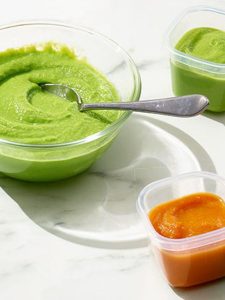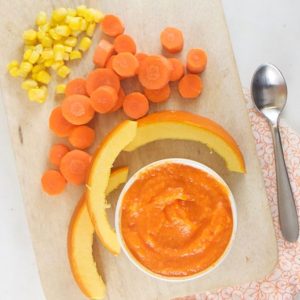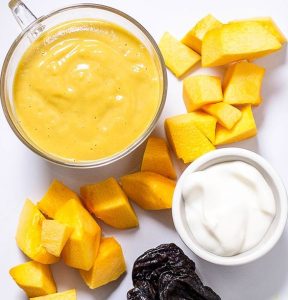Introducing your baby to a world of healthy flavors is an exciting part of parenthood! Vegetable purees are a fantastic first step, packed with essential nutrients and offering a variety of tastes and textures for your little one to explore. Butternut squash, peas, and carrots are great starting points, but there’s a whole garden waiting to be discovered! This article will unveil delicious and nutritious baby vegetable puree combinations to tempt your tiny taste buds.
Beyond the Basics: Expanding Your Baby’s Veggie Repertoire
Once your baby has enjoyed some basic purees, it’s time to broaden their horizons! Here are some tips for introducing new vegetable combinations:
Start familiar, then explore:
Pair a new veggie with one your baby already enjoys. For example, you could try sweet potato and peas or green beans with avocado.
Go gradual:
Don’t overwhelm your baby’s taste buds. Start with a small amount of the new vegetable mixed with a familiar one. Gradually increase the amount of the new veggie over time.
Pay attention to reactions:
Watch for any signs of an allergic reaction. If you notice any concerns, stop feeding your baby the puree and consult your doctor.

Here are some creative baby vegetable puree combinations to try:
- Sweet potato and peas: A classic combination of sweetness and savory flavors.
- Green beans and avocado: Green beans offer a mild flavor that pairs well with the creamy texture of avocado.
- Butternut squash and carrots: This vibrant orange combo is packed with beta-carotene, important for vision health.
- Broccoli and cauliflower: These mild-flavored veggies offer a gentle introduction to cruciferous vegetables.
- Zucchini and spinach: Zucchini adds a touch of sweetness to balance the earthy flavor of spinach.
Remember, it may take your baby a few tries to get used to a new flavor. Don’t be discouraged if they reject a puree at first. Offer it again another time, and be patient.
Color Coordination: Fun and Nutritious Veggie Puree Ideas
Adding a pop of color to your baby’s puree can make mealtime more visually appealing! Here are some ideas for colorful veggie combinations:
- Green: Steam or roast broccoli, zucchini, and peas for a vibrant green puree.
- Orange: Combine sweet potato, carrots, and butternut squash for a sunshine-colored delight.
- Purple: Puree sweet potato with beets (beets should be cooked thoroughly before serving to babies) for a unique and colorful option.
- Red: Roast red bell peppers with sweet potato for a naturally sweet and vibrant puree.
These are just a few ideas to get you started. Experiment with different vegetable combinations to find what your baby enjoys most!
Beyond Purees: Exploring Vegetable Mash and Finger Foods
As your baby gets older and their coordination improves, you can introduce them to different textures. Here are some ideas:
- Vegetable mash: Once your baby is comfortable with purees, you can mash cooked vegetables to a slightly thicker consistency. This helps them develop their chewing skills.
- Steamed veggie sticks: Steaming softens vegetables while preserving nutrients. Offer softer veggie sticks like broccoli florets or sweet potato chunks for your baby to self-feed.
Safety tip: Always supervise your baby closely during mealtimes to prevent choking. Cut vegetables into safe shapes and sizes for them to explore.
The Takeaway: A World of Flavor Awaits!
Introducing your baby to a variety of vegetables is a fantastic way to ensure they get the nutrients they need to thrive. By exploring different vegetable puree combinations and textures, you can create a fun and flavorful foundation for a healthy relationship with food.
Remember: Every baby develops at their own pace. Be patient, have fun, and enjoy this exciting time of discovery with your little one!
Making Mealtime Fun: Presentation and Playtime with Purees
Mealtime can be a fun and interactive experience for your baby! Here are some ideas to make introducing purees enjoyable:
- Get colorful! Arrange purees in fun shapes on a plate using cookie cutters.
- Let them explore! Spoon a small amount of puree onto your baby’s tray and let them touch and explore the texture with their fingers.
- Sing songs and make mealtime a positive experience.
Here are some additional tips for making mealtime fun and stress-free:
- Invest in a fun bib to catch the mess.
- Use a wipeable highchair for easy cleanup.
- Relax and enjoy the process! Mealtime shouldn’t be a battle.
By following these tips, you can create a positive association with food for your baby from the very beginning.
The Joy of Discovery: Experimenting with Baby Vegetable Purees
Introducing your baby to a world of flavors and textures is a rewarding experience. Vegetable purees are a fantastic way to kickstart their culinary journey. With a little creativity and these tips, you can create delicious and nutritious combinations that your baby will love.
Remember: Every baby develops at their own pace. Be patient, have fun, and enjoy this exciting time of discovery with your little one!
Building a Well-Rounded Repertoire: Planning Vegetable Puree Meals
Once you’ve explored some flavor combinations, consider planning a week’s worth of purees to ensure variety and keep mealtimes interesting. Here are some tips:
-
Balance flavors and textures: Offer a mix of sweet, savory, and mild-flavored purees throughout the week. Rotate between smooth and slightly chunkier textures as your baby gets older.
-
Plan around in-season produce: Seasonal vegetables are typically fresher and more affordable. Explore what’s available at your local farmer’s market for inspiration.
-
Consider freezing options: If you’re making large batches, portion purees into ice cube trays for easy freezing and thawing.

Here’s a sample weekly meal plan featuring different baby vegetable puree combinations:
- Day 1: Sweet potato and pear puree
- Day 2: Butternut squash and carrot puree with a hint of cinnamon
- Day 3: Broccoli and apple puree
- Day 4: Green bean and avocado puree
- Day 5: Zucchini and spinach puree
Remember, this is just a sample plan. Feel free to adjust it based on your baby’s preferences and what’s available to you.
Always supervise your baby closely during mealtimes to prevent choking. Cut vegetables into safe shapes and sizes for them to explore. Discard any uneaten teething wafers to prevent choking hazards.



